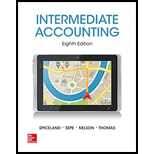
Requirement – 1
Financial ratio:
The financial ratios examine the performance of the company, and used in comparing own business with other same business. It indicates the relationship of two or more items of financial statements.
To determine: The Company that appears more efficient in collecting its
Requirement – 1
Explanation of Solution
Calculations of ratios are as follows:
| Company | Inventory turnover ratio |
Average collection period |
Inventory turnover ratio | Average days in inventory |
| J | 6.37 times (1) | 57 days (3) | 3.39 times (5) | 108 days (7) |
| P | 5.15 times (2) | 71days (4) | 1.68 times (6) | 217 days (8) |
Table (1)
Working Notes:
1. Calculate the
2. Calculate the accounts receivable turnover ratio for Company P.
3. Calculate the Average collection period for Company J.
4. Calculate the Average collection period for Company P.
5. Calculate the inventory turnover ratio for Company J.
6. Calculate the inventory turnover ratio for Company P.
7. Calculate the average days in inventory for Company J.
8. Calculate the average days in inventory for Company P.
- Based on Accounts receivable ratio, the Company J collects their credit receivables within 57 days which is less than 14 days of Company P. Hence, Company J is preferable.
- Based on Inventory turnover ratio, Company J sells its inventory twice more than Company P. Hence, the Company J is preferable.
Requirement – 2
The Company that appears more efficient in greater earnings.
Requirement – 2
Explanation of Solution
Return on assets
It evaluates the efficiency of company’s assets. It reports the profit earned as the percentage of total assets used in the business. A company’s
| Company | Rate of Return on Assets |
| J | 14.90% (9) |
| p | 1.40% (10) |
Table (2)
Working Notes:
1. Calculate the Rate of return on assets for Company J.
2. Calculate the Rate of return on assets for Company P.
Return on assets reports the overall profitability of the company. In this case, Company J has higher rate of profitability compared to Company P.
Requirement – 3
The more efficient company in respective of rate of return on assets with similar combination of profit margin and turnover.
Requirement – 3
Explanation of Solution
Profit Margin:
Profit margin reflects the portion of net income in the net sales. It is a profitability measure tool that is used to evaluate the net income a business earns on every dollar of net sales.
| Company | Rate of Return on Assets |
| J | 14.90% (11) |
| p | 1.40% (12) |
Table (3)
Working Notes:
1. Calculate the rate of return on assets for Company J.
2. Calculate the rate of return on assets for Company P.
In this case, the profit margin and assets turnover for Company J is comparatively higher than Company P; hence Company J is more efficient.
Requirement – 4
The Company that appears more efficient in higher rate of return.
Requirement – 4
Explanation of Solution
| Company | Rate of return on shareholders' equity |
| J | 26.80% (13) |
| p | 2.50% (14) |
Table (4)
Working Notes:
Calculate the Rate of return on shareholders’ equity for J.
Calculate the Rate of return on shareholders’ equity for P.
In this case, Company J provides higher rate of return on shareholders’ equity compared to Company P; hence Company J is more efficient.
Requirement – 5
The Company that appears more efficient in equity multiplier.
Requirement – 5
Explanation of Solution
Equity multiplier shareholders’ equity
Equity multiplier shareholders’ equity is used to measure the company’s financial leverage. If equity multiplier ratio is high it indicates high debt, if the ratio is low it indicates low debt to the company.
| Company | Equity multiplier shareholders' equity |
| J | 1.80 (15) |
| p | 1.79 (16) |
Table (5)
Working Notes:
1. Calculate the equity multiplier shareholders’ equity for Company J.
2. Calculate the equity multiplier shareholders’ equity for Company P.
In this case, both the companies are having similar equity multipliers; it indicates both the companies’ equities are higher than the return on assets.
Want to see more full solutions like this?
Chapter 5 Solutions
INTERMEDIATE ACCOUNTING W/CONNECT PLUS

 AccountingAccountingISBN:9781337272094Author:WARREN, Carl S., Reeve, James M., Duchac, Jonathan E.Publisher:Cengage Learning,
AccountingAccountingISBN:9781337272094Author:WARREN, Carl S., Reeve, James M., Duchac, Jonathan E.Publisher:Cengage Learning, Accounting Information SystemsAccountingISBN:9781337619202Author:Hall, James A.Publisher:Cengage Learning,
Accounting Information SystemsAccountingISBN:9781337619202Author:Hall, James A.Publisher:Cengage Learning, Horngren's Cost Accounting: A Managerial Emphasis...AccountingISBN:9780134475585Author:Srikant M. Datar, Madhav V. RajanPublisher:PEARSON
Horngren's Cost Accounting: A Managerial Emphasis...AccountingISBN:9780134475585Author:Srikant M. Datar, Madhav V. RajanPublisher:PEARSON Intermediate AccountingAccountingISBN:9781259722660Author:J. David Spiceland, Mark W. Nelson, Wayne M ThomasPublisher:McGraw-Hill Education
Intermediate AccountingAccountingISBN:9781259722660Author:J. David Spiceland, Mark W. Nelson, Wayne M ThomasPublisher:McGraw-Hill Education Financial and Managerial AccountingAccountingISBN:9781259726705Author:John J Wild, Ken W. Shaw, Barbara Chiappetta Fundamental Accounting PrinciplesPublisher:McGraw-Hill Education
Financial and Managerial AccountingAccountingISBN:9781259726705Author:John J Wild, Ken W. Shaw, Barbara Chiappetta Fundamental Accounting PrinciplesPublisher:McGraw-Hill Education





